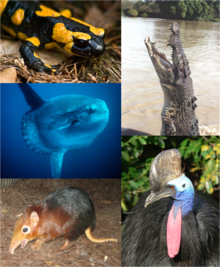Our website is made possible by displaying online advertisements to our visitors.
Please consider supporting us by disabling your ad blocker.
Euteleostomi
| Euteleostomes
| |
|---|---|
 Organisme individu dari setiap kelompok utama Euteleostomi. Berlawanan arah jarum jam, dimulai dari kiri atas: Kecoa api (Amphibia), buaya air asin (Reptilia), kasuari selatan (Aves), tupai gajah raksasa hitam-dan-merah (Mammalia), ikan bulan laut (Osteichthyes) | |
| Subgroups | |
Euteleostomi (Eu-teleostomi, di mana Eu- berasal dari Yunani εὖ 'baik, bagus' atau Euteleostomes, juga dikenal sebagai "ikan tulang belakang") adalah sebuah klad sukses yang mencakup lebih dari 90% dari spesies vertebrata yang hidup. Kedua subkelompok utamanya berhasil hingga saat ini: Actinopterygii mencakup sebagian besar spesies ikan bertulang belakang yang masih ada, dan Sarcopterygii mencakup tetrapoda.[2][3][4]
- ^ Zhao, W.; Zhang, X.; Jia, G.; Shen, Y.; Zhu, M. (2021). "The Silurian-Devonian boundary in East Yunnan (South China) and the minimum constraint for the lungfish-tetrapod split". Science China Earth Sciences. 64 (10): 1784–1797. Bibcode:2021ScChD..64.1784Z. doi:10.1007/s11430-020-9794-8.
- ^ Clack, Jennifer A. (27 Juni 2012). Gaining Ground, Second Edition: The Origin and Evolution of Tetrapods. Indiana University Press. hlm. 21–4. ISBN 978-0-253-00537-3. Diakses tanggal 12 Mei 2015.
- ^ Longo, Sarah; Riccio, Mark; McCune, Amy R (2013). "Homology of lungs and gas bladders: Insights from arterial vasculature". Journal of Morphology. 274 (6): 687–703. doi:10.1002/jmor.20128. ISSN 0362-2525. PMID 23378277.
- ^ McCune, Amy R.; C. Schimenti, John (2012). "Using Genetic Networks and Homology to Understand the Evolution of Phenotypic Traits". Current Genomics. 13 (1): 74–84. doi:10.2174/138920212799034785. ISSN 1389-2029. PMC 3269019
 . PMID 22942677.
. PMID 22942677.
Previous Page Next Page


